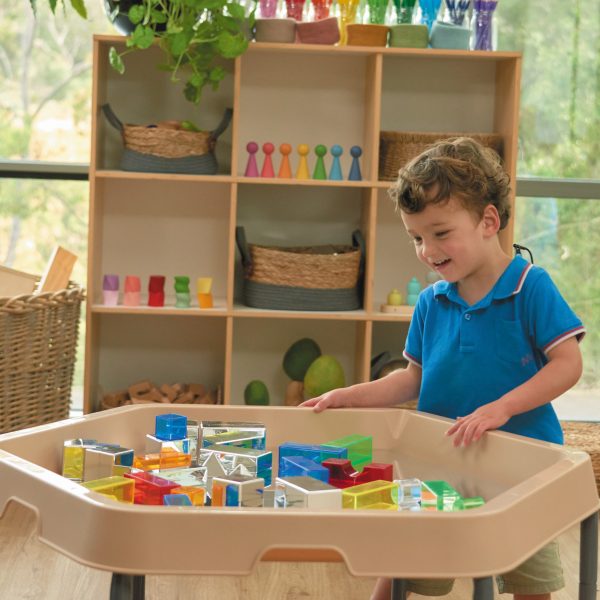Waste not, want not: Reimagining the use of ‘waste’ in children’s play

Reverse Garbage is something of an institution for those early childhood educators living in New South Wales.
The creative reuse centre supports sustainability by reducing waste and creating change in the way that people look at resources. Core to the mission of Reverse Garbage is to support children, adults, artists, educators and teachers to consume less, make more, save money – and feel good doing it.
The non-profit organisation achieves this by diverting industrial and commercial waste from landfill to its warehouse, where educators – among others – can find supplies and inspiration. It also delivers sustainability education to educators, early learners and schools.
Recently the team from Reverse Garbage spoke with the NSW Department of Education, offering ideas about how to reuse and reduce waste in early childhood settings while also creating open ended learning opportunities for children.
An extract of this discussion appears below. For the full information please see here.
Get connected
The first tip from Reverse Garbage’s Education Programs Manager Yasmin Andrew is to invite families and the local community to support sustainability by seeking loose parts donations.
Connections such as local businesses, local ‘buy nothing’ groups, or low cost options such as op shops can all boost play resources in a low cost way.
Families should also be invited and encouraged to donate unused open-ended resources like tennis balls, bottle tops and cardboard boxes.
Play with purpose
When accepting donations, or re-evaluating resources already in the service, consider:
- how objects can be reused, recontextualised and expanded upon – look to children’s interests for inspiration
- what can be ‘rescued’ from recycling, such as cardboard tubes, clean yoghurt pots or delivery boxes
- whether there are any loose parts children can collect outdoors and use in creative, environmentally conscious ways.
Be alert to risk
There are some potential risks or hazards which come from reusing materials in play.
Wherever possible, Ms Andrew advises involving the children in the risk management process in age-appropriate ways.
“You can create valuable learning opportunities as children assess risk, problem solve and make informed decisions about their safety,” she said.
When updating risk assessments and procedures, ask children to share their thoughts and ideas on what can be done differently to support everyone’s safety and learning. Before intervening in children’s loose part play, take a moment to assess if they’re already managing risks in their own way.
Considered choices
Building on considerations of risk, any loose parts introduced to the service should be safe, clean and age appropriate.
For children aged from birth to five years of age, materials which are sharp, pose a choking hazard or could pinch or entrap fingers or other body parts should be avoided.
Any loose parts in the service should be checked regularly to ensure they are in good condition and safe to use. These checks should be added to maintenance and safety checklists to ensure that staff are aware of the need to review, and of any potential hazards which may arise from their presence in the service.
Ms Andrew recommends that any new materials are introduced slowly to the learning environment, to allow children time to explore, and that they are introduced in a ‘scaffolded’ way, where materials which pose less risk are introduced first.
Let children drive
The final tip is to allow children to ‘be the pilots of their play’ through posing open-ended questions or sharing visual provocations which allows space for children to explore their own ideas around a central concept.
“Don’t get over-involved,” Kirsten Junor, CEO of Reverse Garbage, added. “What that does is interfere with a child’s ability to explore their own imagination and creativity.”
“Instead, focus on what that child is doing, the experience they’re having and how they’re making sense of the world.”
An eye to the future
Many loose parts have a finite life, and it is important to consider what will be done to minimise the impact of these materials on the environment once they have served their purpose.
“These cardboard tubes are fun but they will break down,” Ms Junor shared as an example. “So, what do we do with them now? Do they go to the worms? Can we put them in the garden? Should we put them in recycling?”
Discussing the origin and original purpose of reused materials may also encourage children to engage in further inquiry.
Learn more about loose parts and risky play, or access the original coverage of this story here.
Popular

Workforce
Quality
Research
When did it start to go wrong?
2025-12-18 08:00:46
by Fiona Alston

Economics
Provider
Quality
Jobs News
Policy
Practice
Workforce
The year in review: 2025's most impactful ECEC news stories and shifts
2025-12-16 07:32:18
by Fiona Alston

Quality
Provider
Workforce
Practice
Celebrating 10 years of workplace excellence as the sector’s leading Employer of Choice
2025-12-19 07:00:09
by Fiona Alston















